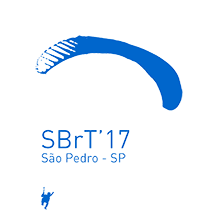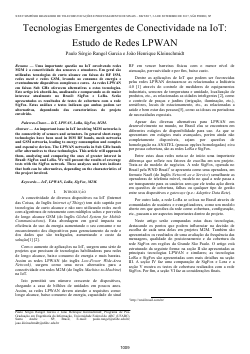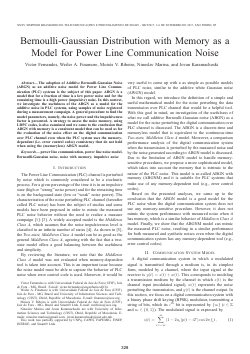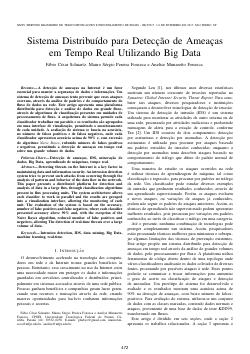
XXXV Simpósio Brasileiro de Telecomunicações e Processamento de Sinais

Decodificação de Viterbi para Codificação Wavelet de Canal
João Fonseca Neto, Leocarlos B. da S. Lima, Francisco M. de Assis
DOI: 10.14209/sbrt.2017.140
Keywords: Codificação de canal wavelet decodificação de canal wavelet decodificação de Viterbi canal com desvanecimento Rayleigh.
Abstract
A codificação wavelet de canal objetiva reduzir efeitos deletérios de canal de comunicação sem fio sobre um sinal transmitido e emprega comumente uma decodificação símbolo a símbolo. Este trabalho investiga o emprego de decodificador de Viterbi para códigos wavelet e compara, em termos da taxa de erro de bits, o desempenho do sistema operando sobre canal com desvanecimento Rayleigh, quando aplicada a decodificação de Viterbi, em relação à decodificação tradicional. Os resultados de simulação demonstraram que a decodificação de sequência proporciona desempenho superior à decodificação símbolo a símbolo.Download

Estrategias de perturbação para metaheurística VNS aplicada ao problema RSA em Redes Ópticas Elásticas
Carlos Magno de O. Araújo, Iguatemi Eduardo da Fonseca, Lucídio A. F. Cabral
DOI: 10.14209/sbrt.2017.144
Keywords: RSA Problem Elastic Optical Networks Metaheuristic
Abstract
The RSA(Routing and Spectrum Allocation) is an optimization problem that aims at to attend traffic demands in a optical network under a given performance criterion. In this paper we address the static version of this problem in the flex-grid optical networks context and analyse the performance improvement of a VNS metaheurisc by using different biased perturbation strategies aided by aleatory method in comparation with pure biased or aleatory perturbation methods. The tests show that different kinds of performance improvements comes with different kinds of perturbation methods.Download

Roteamento ciente de energia em redes de sensores sem fio definidas por software
Doriedson A. G. Oliveira, Cintia B. Margi
DOI: 10.14209/sbrt.2017.108
Keywords: Rede de Sensores Sem Fio redes definidas por software roteamento ciente de energia
Abstract
Redes de sensores sem fio compõe-se de dispositivos com recursos limitados. A comunicação possui o maior consumo de energia, sendo importante otimizar o roteamento de dados. Apesar de propostas de protocolos cientes de energia, existe uma lacuna quando se trata do uso de energia como métrica de roteamento em redes de sensores sem fio definidas por software (SDWSN). Assim, apresentamos uma abordagem de roteamento ciente de energia em SDWSN. Os resultados obtidos, considerando o arcabouço TinySDN, demonstram que combinar as métricas de energia e ETX (Expected Transmission Count) melhora a taxa de entrega de dados e o tempo de vida da rede.Download

Aplicativo Android de Identificação de Soluções Químicas para Deficientes Visuais
Lucas Silva, Jailson Machado Ferreira, Danilo Regis
DOI: 10.14209/sbrt.2017.145
Keywords: Chemistry Image Processing AT Assistive Technology Visually Impaired
Abstract
In Brazil the number of people with disabilities in the academic world is increasing. This project aims to be an Assistive Technology aimed specifically at the large area of Chemistry, assisting the visually impaired through image processing on mobile devices. The application recognizes the color of chemical solutions using the camera of the mobile device. In this project we were able to distinguish seven different colors and their variations of light. A 75% recognition efficiency was obtained for images not used for threshold definition.Download

Tecnologias Emergentes de Conectividade na IoT: Estudo de Redes LPWAN
Paulo Sérgio Rangel Garcia, João Henrique Kleinschmidt
DOI: 10.14209/sbrt.2017.141
Keywords: IoT LPWAN LoRa SigFox M2M
Abstract
Uma importante questão na IoT envolvendo redes M2M é a conectividade dos sensores e atuadores. Em geral são utilizadas tecnologias de curto alcance em faixas de RF ISM, redes mesh e redes GSM, levando ao consumo de energia e eventualmente dispositivos complexos e caros. As redes LPWAN em faixas Sub GHz oferecem alternativas a estas tecnologias. Este artigo irá abordá-las, analisando e comparando as de maior interesse atualmente no Brasil: SigFox e LoRa. Serão apresentados os resultados de testes de cobertura com a rede SigFox. Estas análises e testes indicam que ambas podem ser alternativas, dependendo das características do projeto envolvido.Download

Bernoulli-Gaussian Distribution with Memory as a Model for Power Line Communication Noise
Victor Fernandes, Weiler A. Finamore, Mois´es V. Ribeiro, Ninoslav Marina, Jovan Karamachoski
DOI: 10.14209/sbrt.2017.152
Keywords: power line communication power line noise model Bernoulli-Gaussian noise noise with memory impulsive noise
Abstract
The adoption of Additive Bernoulli-Gaussian Noise (ABGN) as an additive noise model for Power Line Communication (PLC) systems is the subject of this paper. ABGN is a model that for a fraction of time is a low power noise and for the remaining time is a high power (impulsive) noise. In this context, we investigate the usefulness of the ABGN as a model for the additive noise in PLC systems, using samples of noise registered during a measurement campaign. A general procedure to find the model parameters, namely, the noise power and the impulsiveness factor is presented. A strategy to assess the noise memory, using LDPC codes, is also examined and we came to the conclusion that ABGN with memory is a consistent model that can be used as for the evaluation of the noise effect on the digital communication over PLC channel even when the PLC system uses the memorydependent (i.e. error control codes) consistency that do not hold when using the (memoryless) ABGN model.Download

Cancelamento de Distorções Não Lineares em Sistemas OFDM Cooperativos AF
Felipe Cardoso dos Anjos, Carlos Alexandre Rolim Fernandes
DOI: 10.14209/sbrt.2017.146
Keywords: OFDM cooperative systems iterative correction hard detection nonlinear amplifier
Abstract
In this paper, we propose an iterative technique for canceling nonlinear distortions in cooperative OFDM systems AF. The proposed technique estimates and cancels the nonlinear distortions caused by the use of PAs at source and relay. With this technique the receiver will estimate the nonlinear distortions of the source and these estimates will aid in the detection and cancellation of the nonlinear distortions of the relay. The proposed system was evaluated through numerical simulations. The obtained results showed that the proposed technique has a great hability to cancel the nonlinear distortions, providing results very close to the case with linear PAs.Download

Energy Map Model for Software-Defined Wireless Sensor Networks
Gustavo A. Núñez, Cintia B. Margi
DOI: 10.14209/sbrt.2017.147
Keywords: Wireless Sensor Networks Software-Defined Networking energy map
Abstract
Wireless sensor networks (WSN) is a technology commonly used for remote monitoring, tracking and detection applications. Since energy efficiency is a major concern in WSN, to know the remaining energy on each node could optimize the energy consumption. We propose a novel method to create an energy map for a Software-Defined Wireless Sensor Network (SDWSN). We implement an energy consumption prediction model into the controller, which obtains information of each node and estimates its energy consumption rate. This approach reduces the node processing overhead and memory usage when compared to other approach available.Download

Sistema Distribuído para Detecção de Ameaças em Tempo Real Utilizando Big Data
Fábio César Schuartz, Mauro Sérgio Pereira Fonseca, Anelise Munaretto Fonseca
DOI: 10.14209/sbrt.2017.265
Keywords:
Abstract
Detecting threats on the Internet is a key factor in maintaining data and information security. An intrusion detection system tries to prevent such attacks from occurring through the analysis of patterns and behavior of the data flow in the network. This paper presents a distributed platform for detection and analysis of data in a large flux, through classification algorithms present in flux processing units. The system architecture allows each classifier to work in parallel and the results are grouped into a visualization interface, allowing the monitoring of each unit. The evaluation of the system is based on the accuracy, number of false positives and false negatives, where each classifier presented accuracy above 90% and, with the exception of the Naive Bayes algorithm, reduced number of false positives and negatives, allowing The detection of real-time threats over a large volume of data.Download

Development of an 1-Seg ISDB-T Receiver Using Low-cost SDR Hardware
Leonardo Muttoni, Antônio C. Veiga
DOI: 10.14209/sbrt.2017.153
Keywords: ISDB-T SDR OFDM RTL-SDR
Abstract
This paper presents the development of an onesegment (1-seg) digital TV receiver for the Integrated Services Digital Broadcasting - Terrestrial (ISDB-T) standard, based on Software Defined Radio (SDR). The proposed receiver works in real-time and requires a computer and a low-cost device known as RTL-SDR, for the RF front-end, mixer and analog to digital conversion stages. The rest of signal processing were all done in software, which provides an important framework for study of the ISDB-T standard in practice.Download